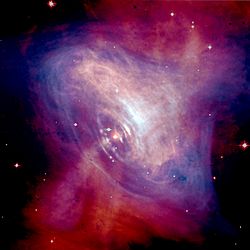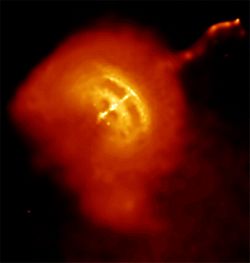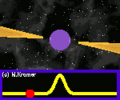Pulsar facts for kids

Pulsars are neutron stars which spin rapidly and produce huge electromagnetic radiation along a narrow beam. Neutron stars are very dense, and have short, regular spins. This produces a very precise interval between pulses that range from roughly milliseconds to seconds for an individual pulsar. The pulse can only be seen if the Earth is close enough to the direction of the beam. Similar to how you can only see a lighthouse when the beam is shining at your direction.
The pulses match the star's turns. The spinning causes a lighthouse effect, as the radiation is only seen at short intervals. Werner Becker of the Max Planck Institute for Extraterrestrial Physics recently said,
- "The theory of how pulsars emit their radiation is still in its infancy, even after nearly forty years of work. There are many models but no accepted theory".
Contents
Discovery
The first pulsar was discovered in 1967 by Jocelyn Bell Burnell and Antony Hewish of the University of Cambridge. The observed emission had pulses separated by 1.33 seconds, coming from the same place in the sky. The source kept to sidereal time. At first, they did not understand why pulsars have a regular change in the strength of radiation. The word pulsar is short for "pulsating star".
This original pulsar, now called CP 1919, produces radio wavelengths, but pulsars have later been found to produce radiation in the X-ray and/or gamma ray wavelengths.
Nobel prizes
In 1974, Antony Hewish became the first astronomer to be awarded the Nobel Prize in Physics. Controversy occurred because he was awarded the prize while Bell was not. She had made the initial discovery while she was his Ph.D student. Bell claims no bitterness upon this point, supporting the decision of the Nobel prize committee. "Some people call it the No-Bell prize because they feel so strongly that Jocelyn Bell Burnell should have shared in the award".
In 1974, Joseph Hooton Taylor Jr. and Russell Hulse discovered for the first time a pulsar in a binary system. This pulsar orbits another neutron star with an orbital period of just eight hours. Einstein's theory of general relativity predicts that this system should emit strong gravitational radiation, causing the orbit to continually contract as it loses orbital energy. Observations of the pulsar soon confirmed this prediction, providing the first ever evidence of the existence of gravitational waves. As of 2010, observations of this pulsar continue to agree with general relativity. In 1993, the Nobel Prize in Physics was awarded to Taylor and Hulse for the discovery of this pulsar.
Kinds of pulsars
Astronomers know that there are three different kinds of pulsars:
- Rotation-powered pulsars, where the radiation is caused by the loss of rotational energy; radiation is caused by the neutron star slowing down in the speed in which it turns
- Accretion-powered pulsars (which are most but not all X-ray pulsars), where the gravitational potential energy of matter that falls onto the pulsar causes X-rays that can be received from Earth, and
- Magnetars, where an extremely strong magnetic field loses energy, which causes the radiation.
Although all three kinds of objects are neutron stars, the things that they can be seen to do and the physics that causes this are very different. But there are some things that are similar. For example, X-ray pulsars are probably old rotation-powered pulsars that have already lost most of their energy, and can only be seen again after their binary companions expanded and matter from them started falling onto the neutron star. The process of accretion (matter falling onto the neutron star) can in turn give enough angular momentum energy to the neutron star to change it into a rotation-powered millisecond pulsar.
Uses
Precise clocks
For some millisecond pulsars, the regularity of pulsation is more precise than an atomic clock. This stability allows millisecond pulsars to be used in establishing ephemeris time, or building pulsar clocks.
Timing noise is the name for rotational irregularities observed in all pulsars. This timing noise is observable as random wandering in the pulse frequency or phase. It is unknown whether timing noise is related to pulsar glitches.
Other uses
The study of pulsars has resulted in many uses in physics and astronomy. Major examples include the proof of gravitational radiation as forecasted by general relativity and the first proof of exoplanets. In the 1980s, astronomers measured pulsar radiation to prove that the North American and European continents are drifting away from one another. This movement is evidence of plate tectonics.
Images for kids
-
Illustration of the "lighthouse" effect produced by a pulsar.
-
Chart on which Jocelyn Bell first recognised evidence of a pulsar, exhibited at Cambridge University Library
See also
 In Spanish: Púlsar para niños
In Spanish: Púlsar para niños








